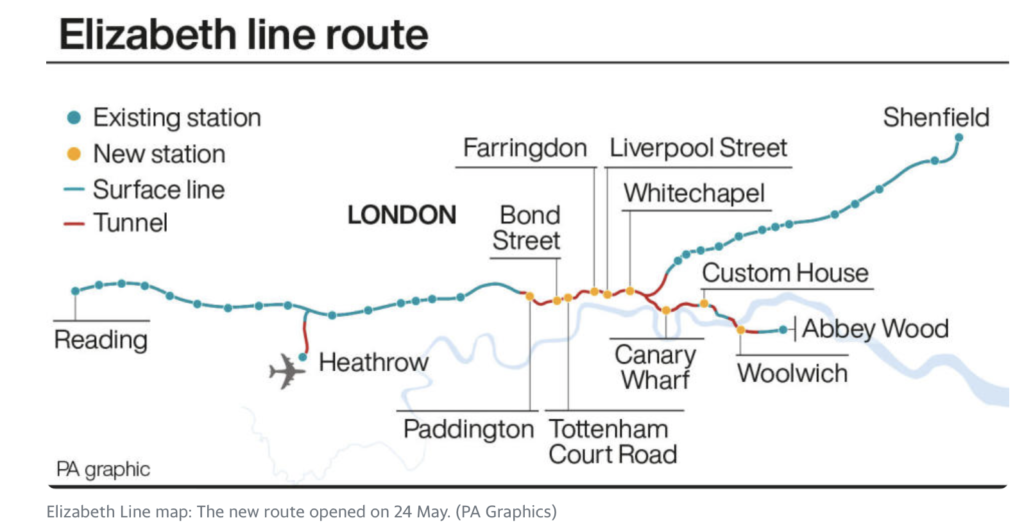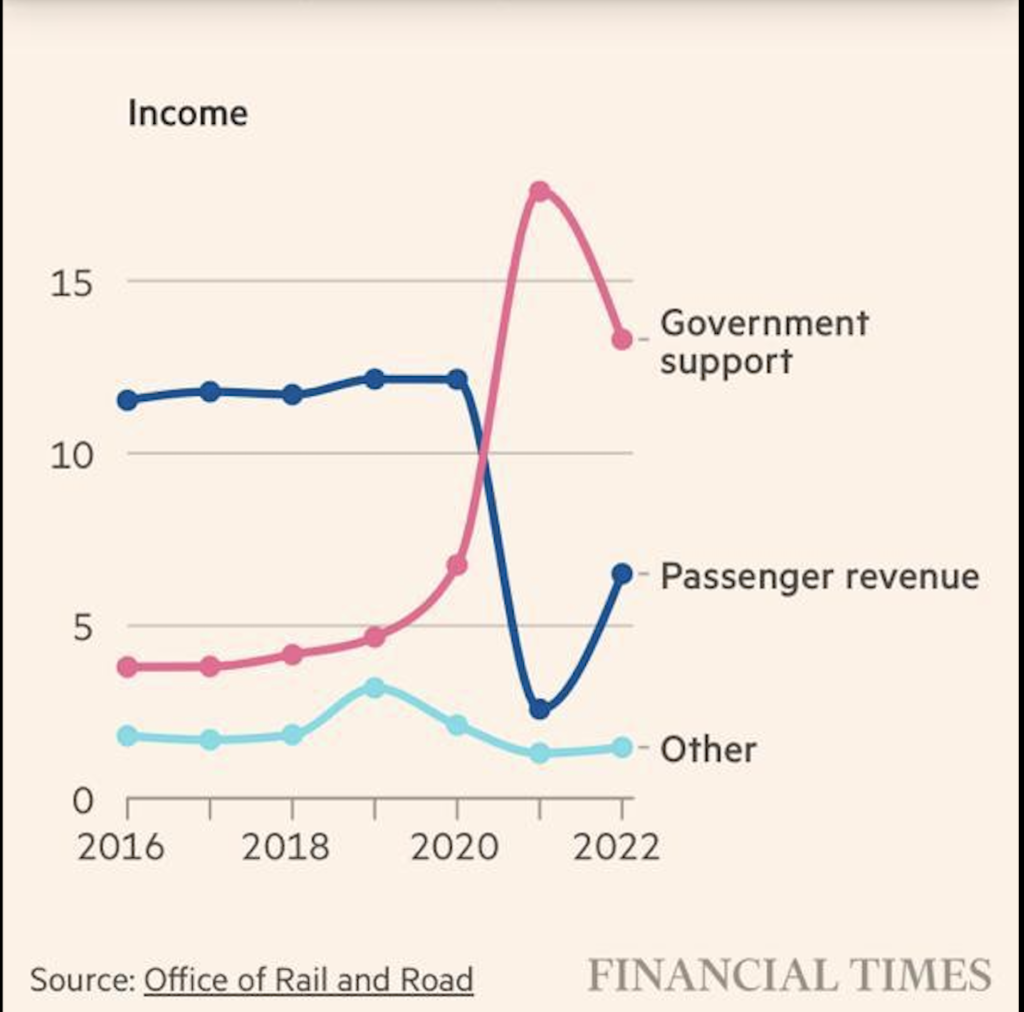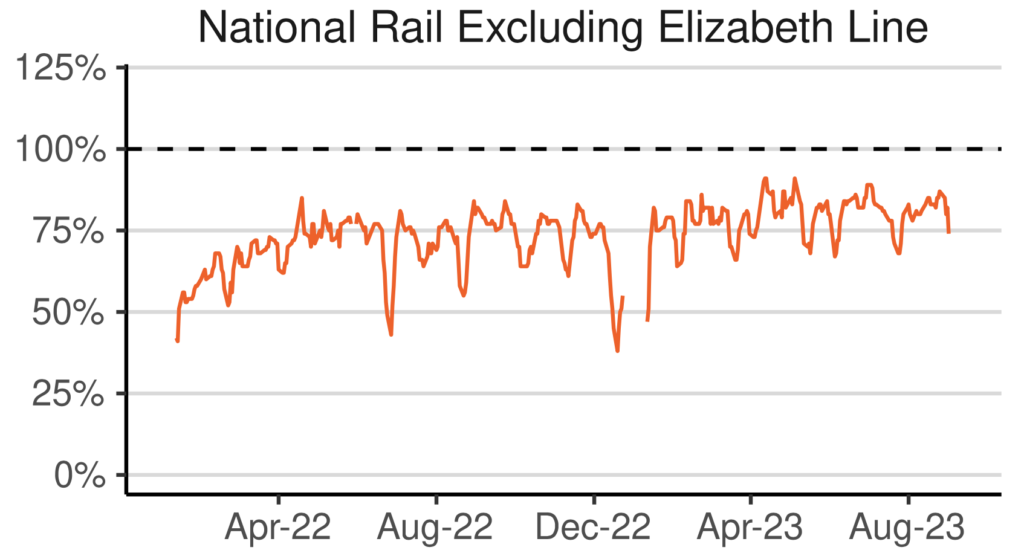The Elizabeth Line – a sensible public investment.

Figure 1 Elizabeth Line Map. Pretty obvious why it carries so much traffic.
The Elizabeth Line (Figure 1) was built for a capital cost of £20 billion and carries 500,000 commuters to London every day. The capital cost per commuter is therefore £40,000 (20 billion / 500,000). That’s the cost of a fairly expensive new car. The number of Elizabeth Line daily commuters was recently reported to have reached 738,000 which would be £27,100 capital cost per commuter. One can see that this is a sensible use of public money – effectively the commuter is renting their seat on the train through ticket sales.
The UK Rail Finances from the Office of Road and Rail.
The Financial Times recently published the Office of Road and Rail Income figures in graphical form see Figure 2.

Figure 2 Office of Road and Rail Income Figures
The railways have needed a substantial subsidy for a long time. The changed travel patterns during and since the pandemic have had a huge effect on passenger revenue and hence the subsidy required to keep the network going. Not only have rail passenger numbers dropped, but there has also been a shift from business to leisure travel and hence a reduction in peak rate ticket sales. Part of the discussion about the recovery since the pandemic centres on whether to include the Elizabeth Line which only opened after the pandemic and, despite being mainly a London local transport scheme, is sometimes included in the figures for intercity rail passengers. Figure 3 is up to date and excludes the Elizabeth Line. The passenger numbers are between 75% and 80% of pre-pandemic numbers. But fare revenue will be lower than that due to the shift to leisure travel. EWR is being built for business travel. In February 2023, Mark Harper stated that season ticket sales were at only 28% of pre-pandemic levels.

Figure 3 Rail Passenger use Excl. Elizabeth line c.f. pre-pandemic. Source: Department for Transport.
It is interesting that both Prime Minister Rishi Sunak and Transport Secretary Mark Harper referred to a permanent shift in post pandemic business travel patterns as part of the justification for cancelling the second phase on HS2 at the 2023 Conservative Party Conference.
Proposed East West Rail Bedford to Cambridge (EWR CS3)
In our previous post on this subject, we explained that the capital cost estimate of EWR CS3 in today’s money is £7.85billion[1] and the number of Cambridge commuters using EWRCo.’s “Theory of Change Trip End Model, Conventional Scenario” would be 472. Not 472,000, but just 472 and this model is calibrated on pre-pandemic behaviour reported in the 2011 census, also ignoring the effect of the new A421/A428 dual carriageway now under construction and running alongside the route and also ignoring the effect of the Cambridge South Station also under construction.
The EWR CS3 capital cost per Cambridge commuter therefore works out at £16.7million (£7.85billion/472). I did look at the most expensive cars in the world to find an equivalent, but it seems that a personal helicopter for each commuter might be a better comparison. One for each day of the week.
Optimism Bias
If you are trying to justify a publicly funded project and know that (a) you will be long gone by the time the project is executed (b) it’s not your money and (c) suspect that there is competition for the same funds from other project proposals; you might as well present the best possible picture. The alternative is that you don’t get funded at all.
This is a well-known effect and is termed “Optimism Bias”. The National Audit Office recently published a Good Practice Guide where on page 13 we find the following statement:
“optimism bias is a well-established concept, with a substantial body of research showing that forecast costs and benefits are generally highly inaccurate. More recently our work showed over-optimism was still an entrenched problem in government.”
Margaret Thatcher is a marmite figure, but one of her quotes seems appropriate here. “The problem with socialism is that you eventually run out of other people’s money.”
Even with all the green field housing, the cost per commuter is still in personal helicopter territory at £3.75million (£7.85billion/2090) although now you would have to make do with using the same helicopter every day. If you think the houses will be built or you believe EWRCo.’s “very aspirational” model parameters, use those. The best capital cost per rail commuter I can get, even taking all EWRCo. optimism bias is around £1 million per rail commuter.
I don’t think it’s reasonable for the taxpayer to subsidize these commuters that much. What would the ticket price have to be to break even without a subsidy? Asking the Cambridge commuter to pay £16.7million up-front is a big ask, but perhaps generations of commuters could pay it back over the 60 year life of the railway. That would be £1,265 per workday but £4,010 allowing for a 5% interest rate on the loaned capital. The assumed subsidy is so high the rail fare is irrelevant. On the other hand, who is going to pay £4,010 a day for a return rail ticket? No one.
We have heard that Beth West recently announced that EWRCo. were seeking reduce the capital cost of the project by reducing the amount of civil engineering. What would the capital cost have to be in order to be comparable with the Elizabeth Line in terms of capital cost per commuter? Let’s give EWRCo. a break and assume that somehow the green-field houses are built and also assume that the target is a capital cost of £40,000 per Cambridge commuter as we saw with the Elizabeth Line. The target capital cost for EWR CS3 becomes £40,000 x 2,090 = £83.6 million. They would need to cut out 99% of the capital cost. If they can do that, it would be scandalous that they ever proposed the current costs.
EWRCo. assume houses for 213,300 people are built – let’s assume that’s 100,000 houses[2]. Taylor Wimpey Ltd recently reported a gross margin of 25% on their house building. [3] At £300,000 per house that’s a gross profit of £7.5billion. About the same as the capital cost of the railway. Can we offset the cost of the railway with housing profits? Surprise windfall tax on property developers and land owners anybody?
A Possible EWR Timeline and Financial Summary
Here is a prediction of what would happen if this project went ahead.
- The taxpayer funds EWR CS3 for £7.85billion
- 472 Cambridge rail commuters.
- Local authorities grant permission for 100k new houses, which are constructed and sold to new people. {This is a high risk step and may well not happen}
- Landowners and property developers make a profit of £7.5billion
- Another 1,618 rail and 9,115 road commuters to Cambridge
- Railway shut down because the subsidy required to keep it running is too high.
The net transaction is a transfer of £7.5billion from the taxpayer to property developers (steps 1 and 4), new towns on green field sites and more road congestion. The government will claw back some of the profits of the property developers through taxation. However, if you really want to supersize Cambridge, there are less financially daft transport schemes. Such as busways and light rail networks.
[1] EWRCo. and DFT quote numbers in the £5-6billion range, and it depends on how much of the risk estimate is included and also whether inflation is allowed for. There is a huge problem even at £5 billion capital cost
[2] Economic and Technical Report Appendix 4 Table 4.1. 99% of these people do not use the railway to commute to Cambridge.
[3] See Companies House Taylor Wimpey UK Limited Account to 31st December 2022, p.26
10 replies on “The Elizabeth Line, EWR CS3, Optimism Bias and Housing Finances.”
Labour are promising *millions* of affordable houses built along railway lines should they win the next election
This illustrates perfectly that there is no business case for EWR , hence their reluctance to offer one early in the consultation. It’s time to stop it NOW.
We all know that 7.5 billion is just the starting point. The reality will be
far higher, as always.
You are correct in saying that there is no business case for EWR – as far as we can make out, one doesn’t exist. Hasn’t been published. Those of us affected by the Bedford section have seen nothing that could possibly resemble a business case.
– We all need to – and ask others to – write to Mark Harper and other politicians (who do you recommend?) to ram home the failed HS2 thinking on EWR.
Good question, Richard. We recently updated our “support us” page which has some ideas about who to write to.
https://cambridgeapproaches.org/support-us/
£7.5Bn is the initial build cost. It is bound to be understated like HS2 and every other major project. This is a white elephant, a complete waste of tax payers money and should be scrapped. I have sent the link to Anthony Brown and Chris Carter-Chapman
How can we get this drummed into minds of Labour politicians? Today they sound like Tories- weaken planning controls, build many houses, fund infrastructure- if I thought infrastructure meant renewable energy sources and cycle tracks Id be in favour… but Im afraid it doesn’t.
Also national publicity following on current accounts of HS2 destruction and money squandering to show EWR is in same category of project
Excellent demonstration of the obscene reality that EWR is really a jackpot bonanza for land owners and property developers. There are real local and regional transport challenges to solve for Cambridge (and Bedford, and Oxford), but EWR is not the answer, not even part of an answer – time to scrap it.
Folk have no idea the total block on active travel about to be inflicted in this area.
I experience this every flipping time I try to cycle through MK on my way to Oxford. Wether this is the closure of National Cycle Network 51 on the Way to Winslow or closure of a footpath under the old varsity line at Bow Brickhill. There is no information about these closures: when they will take place, when they will reopen, or on what authority. Even the local councillors have no information about the closures.
If you enjoy walking, cycling, or horse riding then expect sheer hell to be unleashed.